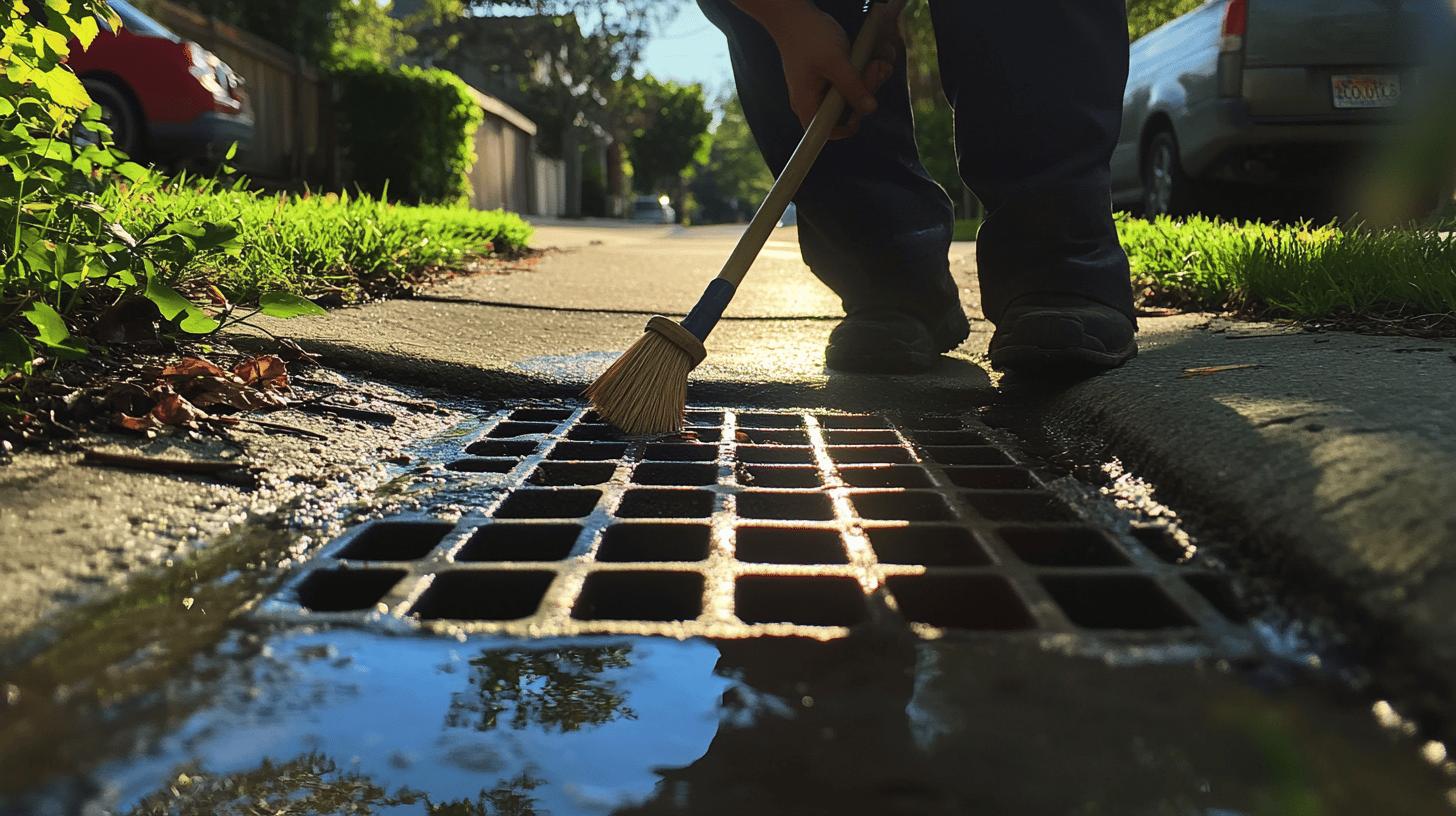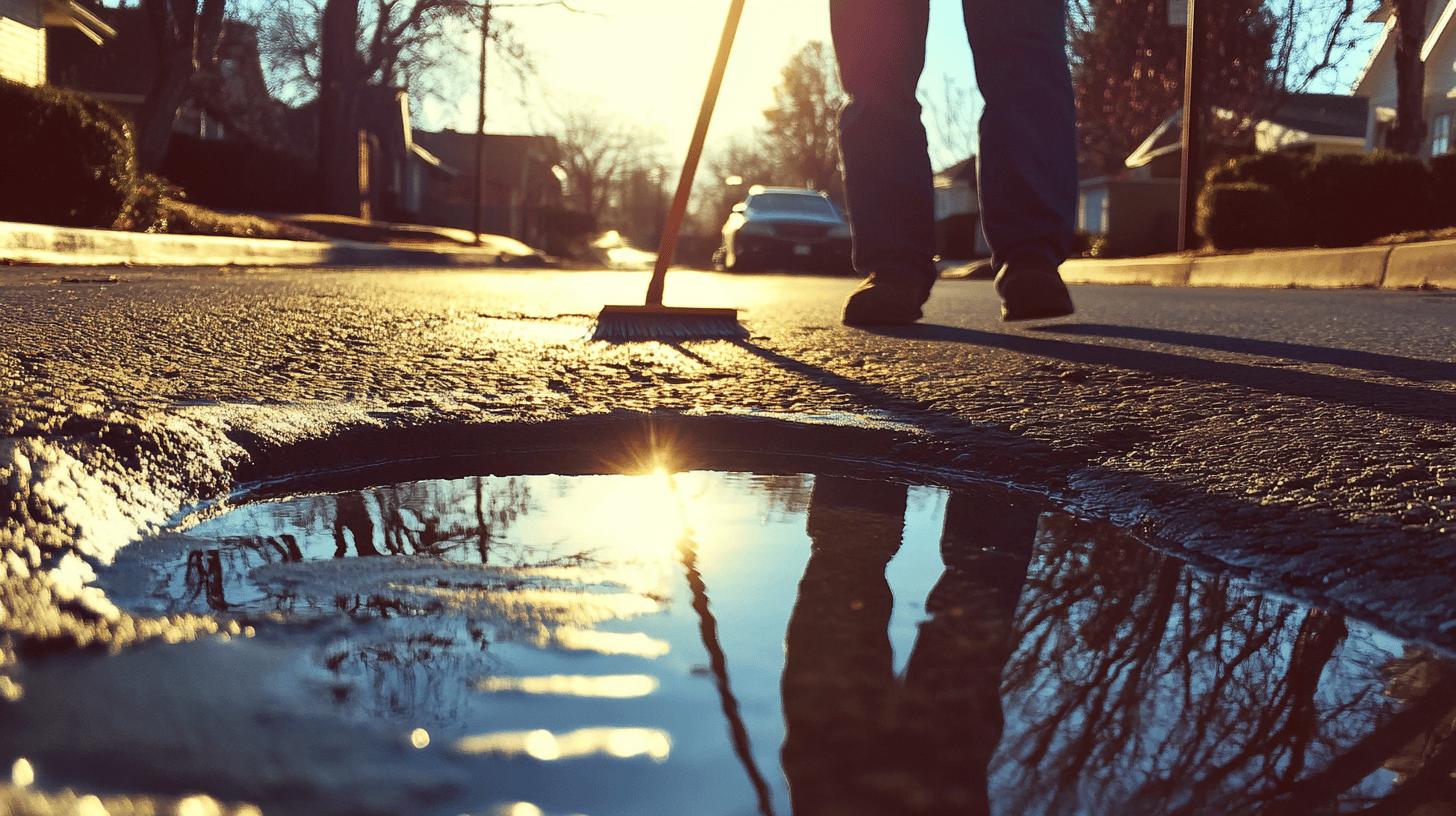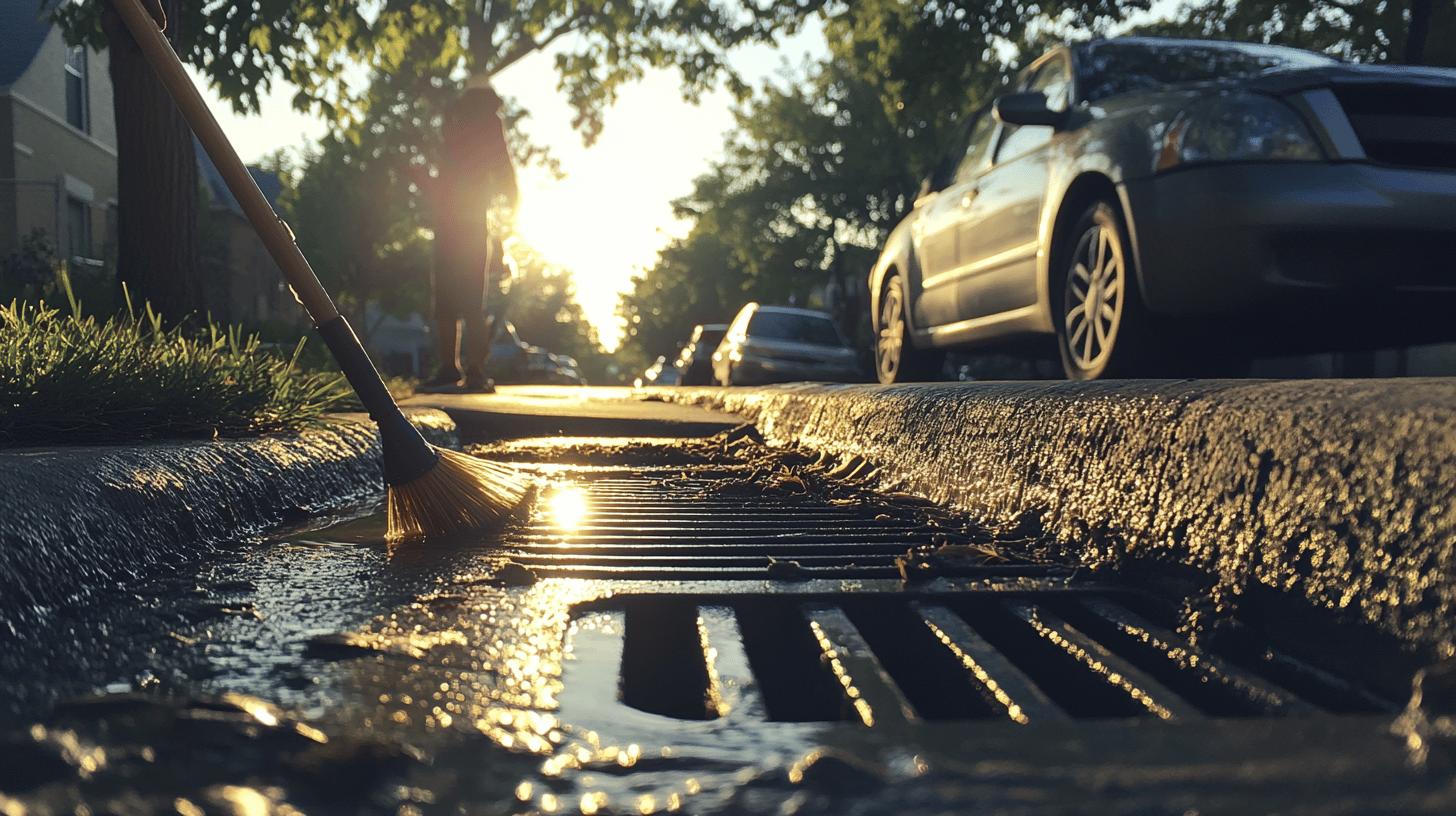TL;DR:
- Importance of Maintenance: Prevents flooding and environmental pollution.
- Who Cleans: Homeowners maintain their drains; city officials manage public ones.
- Clog Causes: Leaves, dirt, trash, twigs, sediment.
- Cleaning Tools:
- High-Powered Water Jetting: Clears tough clogs.
- Vacuum Trucks: Suction large debris.
- Clam Shell Trucks: Remove sediment from basins.
- Manual Tools: Homeowners use for minor debris.
- Risks of Clogs: Cause flooding and pollute waterways.
- Eco-Friendly Methods: Biodegradable agents, regular maintenance, debris barriers.
- Professional Help: Required for hazardous waste and tough blockages; use advanced tools.
Did you know that ignoring your storm drain could lead to major flooding and environmental problems? Storm drains manage rainwater and help keep your neighborhood safe from water damage. Regular cleaning keeps them working well and prevents pollution. In this guide, we’ll break down why storm drain cleaning is important, the tools you’ll need, and the best ways to maintain them. Join us to learn how to keep your storm drain in top shape, avoiding floods and expensive repairs.
Understanding Storm Drain Cleaning Basics
Why is storm drain maintenance important? Mainly to prevent flooding and protect the environment. Storm drains help cities by directing rainwater away from streets and buildings. Regular cleaning keeps them working properly. If they get clogged, flooding and pollution can happen as debris and pollutants build up.
Who should clean storm drains? Homeowners are responsible for drains on their property, meaning they need to check and clean them regularly to avoid blockages. City officials handle public drains, ensuring they’re clear to protect city infrastructure and public safety.
Common causes of storm drain clogs include:
- Leaves
- Dirt
- Trash
- Twigs
- Sediment
Knowing what causes clogs helps you keep storm drains clear, protecting both the environment and your property from damage.
Tools and Equipment for Effective Storm Drain Cleaning

Cleaning storm drains properly needs the right tools. Professionals use equipment like high-powered water jets and vacuum trucks, while homeowners can handle smaller jobs with manual tools. The right tool depends on how bad the blockage is.
High-Powered Water Jetting
This method uses powerful water streams to clear storm drain clogs and debris. It’s effective at breaking up tough blockages and flushing out sediment, making it a dependable way to keep drains clean.
Vacuum Trucks
Vacuum trucks use powerful suction to clear large amounts of debris from storm drains. They’re typically used for bigger, more complex jobs and are often operated by professional services because of their high cost and specialized nature.
Clam Shell Trucks
Clam-shell trucks are equipped with hydraulic buckets that scoop out sediment and large debris from catch basins. They’re perfect for deep maintenance, helping clear out sediment buildup and preventing blockages.
Manual Tools
Homeowners can use basic tools like shovels, rakes, and grabbers to clear minor debris from storm drains. While not as powerful as professional equipment, these manual tools are great for regularly removing leaves, dirt, and small trash, helping to keep drains clear.
| Tool | Use |
|———————-|———————————————|
| High-Powered Water Jetting | Clearing blockages and debris |
| Vacuum Trucks | Suctioning debris from drains |
| Clam Shell Trucks | Removing sediment from catch basins |
| Manual Tools | Minor debris removal by homeowners |
Safe and Eco-Friendly Methods for Storm Drain Cleaning
Clogged storm drains can lead to flooding and let pollutants enter waterways, which can damage property and harm aquatic life. Regular maintenance is key to avoiding these issues and keeping your neighborhood safe.
Some eco-friendly cleaning solutions include:
- Biodegradable cleaning agents
- Regular maintenance schedules
- Installing barriers to catch large debris
- Natural landscaping to reduce runoff
Professional handling is essential for hazardous waste because storm drains can collect toxic substances like motor oil and antifreeze. Experts use the right tools to safely remove these pollutants, keeping the environment safe. If not handled properly, it can lead to more pollution and health risks.
Step-by-Step Guide to Cleaning a Storm Drain

Regular inspections are important because they help catch blockages before they become serious problems and keep the drainage system running smoothly. By spotting clogs early, you can reduce the risk of flooding and environmental damage. Monitoring your storm drains allows you to fix issues before they get worse, ensuring everything works as it should.
Steps for Cleaning a Storm Drain
-
Inspect the Drain
Check the storm drain for debris or blockages. Look for items like leaves and dirt that stop water flow. Use a flashlight to see deeper if needed. -
Gather Necessary Tools
Get gloves, a rake, a trash bag, and a hose with a nozzle. Goggles and a mask protect against debris. -
Remove Surface Debris
Clear surface debris around the drain with a rake or shovel. Put collected waste in a trash bag.
-
Open the Drain Grate
If needed, lift the grate to access the drain. Be careful; it can be heavy or sharp. Place it safely aside. -
Clear the Inside of the Drain
Remove any debris from inside. Watch for sharp objects or hazardous materials. Dispose of waste in a trash bag. -
Rinse the Drain
Use a high-pressure hose to clean the inside of the drain. This helps wash away dirt and keep water flowing smoothly. Make sure to direct the water towards the street or a drainage area.
When should you call in the pros? If you have tough blockages or complicated issues that go beyond just removing debris. Professionals have advanced tools and techniques to tackle serious problems, like roots getting into the drains, ensuring everything runs efficiently.
The Role of Professionals in Storm Drain Cleaning
Why do you need professional services for storm drain cleaning? They use advanced techniques like hydro excavation and video inspections. Hydro excavation combines water and a vacuum to safely remove debris. Video inspections help experts check the pipes for cracks or sediment buildup. These technologies make sure drains are thoroughly examined and cleaned.
Advantages of hiring professionals:
- Thorough cleaning and emergency assistance
- Expertise in complex issues like root intrusions
- Specialized tools and trained personnel
- Emergency services for severe clogs
Pros tackle issues that regular methods can’t handle, making sure storm drains stay functional and reliable.
Final Words
Knowing how to care for storm drains helps you manage water flow and reduce flooding risks. With the right cleaning tools, you can safely handle minor debris yourself. Focusing on eco-friendly methods also protects the environment and lessens your drain’s impact on nature.
A structured cleaning approach ensures your storm drains work well. For tougher problems, professional services provide advanced solutions for thorough maintenance. The best way to keep your storm drain clean is to combine your efforts with professional help. Use these strategies for effective stormwater management.
FAQ
What is the best way to clean a storm drain without professionals?
Cleaning a storm drain without professionals involves removing visible debris manually, using a plumbing snake for minor clogs, and flushing with water. Larger blockages might require professional tools or services.
Who is responsible for cleaning storm drains?
Homeowners are responsible for drains on private properties. In contrast, city authorities manage public storm drains to ensure community-wide functionality and safety.
How do you clean a rainwater drain effectively?
To clean a rainwater drain, inspect for debris, remove blockages with a rake or stick, and flush with water to ensure clear passage. Routine checks help maintain efficiency.
What tools are needed for storm drain cleaning?
Storm drain cleaning may require high-powered water jetting for blockages, vacuum trucks for suctioning debris, clam shell trucks for sediment removal, and manual tools for minor debris.
How much does storm drain cleaning cost?
Storm drain cleaning costs vary based on blockage severity, location, and required tools. Contact local services for estimates, comparing the costs of equipment rental versus professional service fees.
Are there eco-friendly methods for cleaning storm drains?
Eco-friendly storm drain cleaning includes using non-toxic cleaners, effective debris removal, safe waste disposal, and employing professionals for hazardous materials. These practices help minimize environmental risks.
Why hire professionals for storm drain cleaning?
Hiring professionals ensures effective storm drain cleaning using advanced techniques and equipment, such as hydro excavation and video pipe inspections, to address complex issues and provide emergency services.

